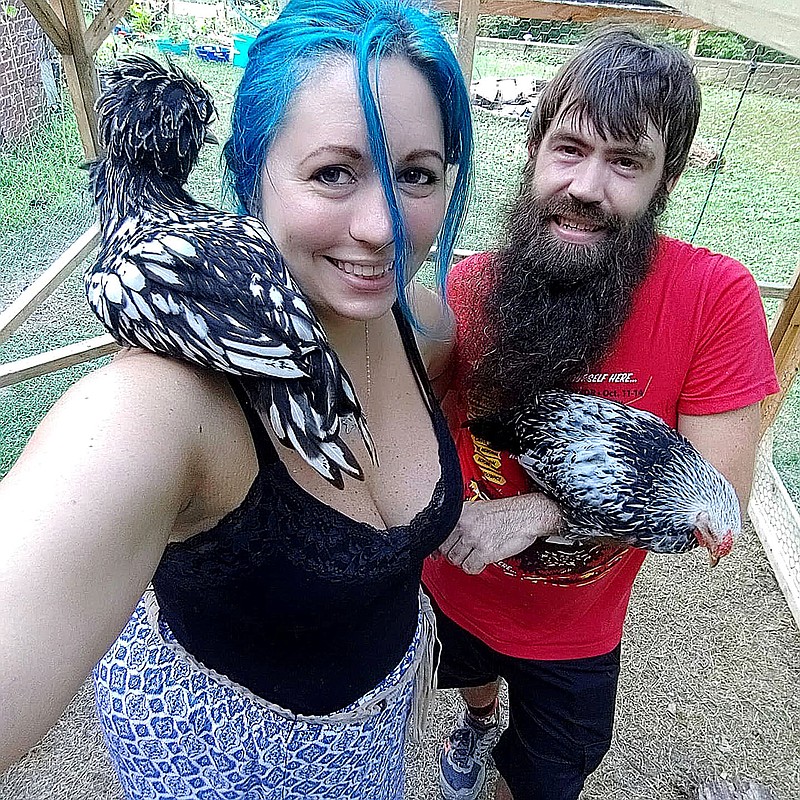In a locale that is home to the names Tyson and Simmon's, chickens are part of the everyday landscape. Chicken houses line many byways and chicken products line many shelves.
As a child, Nicole Ridlen remembers moving from California to Missouri and raising chickens for the first time at her new home. In fact, reminiscing on her youth spent tending to a flock inspired her to revisit the venture with her partner, Brandon VanDalsem, earlier this year.
"For me, since I raised chicks as a kid, it wasn't hard for me to get back into it," Ridlen said. "Chickens are relatively easy once you get the basic needs down -- coop, run, waterer, food dispenser."
The couple began with nine chickens but soon found out that three of the chicks were roosters and whittled the flock down to seven. Ridlen explained that if the rooster to hen ratio is skewed, it will affect the overall wellness of the egg-laying hens. She said it is not advised to have more than one rooster per ten to fifteen hens. To prevent this, two of the roosters were gifted to a neighbor who expressed interest in beginning a flock.
To start their flock, Ridlen and VanDalsem purchased a variety of breeds -- two Polish Crested, two Silver-Lace Wyandotte, two Speckled Sussex (that turned out to be roosters), Two Easter Eggers pullets and one rooster, a Wyandotte.
The flock quickly acclimated and became part of the family.
"We treat them as pets ... basically pets that give us food," Ridlen said. "We named all of them. Mostly after geology and weather themes since [Brandon and I] are storm chasers and rock hounds together."
The flock consists of Mafic and Felsic, the Easter Eggers named for rock compositions; Moly and Goldie, the Polish Crested, named for minerals that match their coloring; Chatty and Storm, the Silver-Lace Wyandottes, named respectively for their talkative nature and dark coloring, and Wheaton, the rooster named for the location of the first tornado footage that the couple captured together.
Ridlen said that, aside from appearances, different breeds provide different sizes and colors of eggs.
"We don't have any bantams but we do have hens that will lay white, brown and green-blue eggs, so it will be a nice color variety."
Ridlen and VanDalsem will have to wait a few more weeks to see their bounty though, as these hens were born on May 20 and they begin laying at 16-24 weeks.
"Of course, the different breeds do have different personalities and, since they are pets, it is fun to watch them grow," Ridlen said. "They all have different traits that make them fun, unique individuals."
"Mafic has a unique personality. She wants to jump up and perch on us when we go in. She will jump on your arm if you hold it out. Moly will sit on my shoulder for a long time, and she is quite talkative when she wants mealworms," Ridlen said. "Wheaton is such a great rooster. He makes sure everyone is in the coop at dusk before he goes in to roost. He will herd them into the coop if any hens are dilly-dallying."
Chicks spend the first six to seven weeks of their lives in a brooder, a heated area to contain chicks that aren't hatched by a hen. Ridlen and VanDalsem improvised and used a pop-up playpen and a heat lamp to accommodate the new chicks.
During this time, ValDalsem got to work building a coop to shelter the chicks and a run for them to roam. Ridlen said both the coop and run should be fully-enclosed to deter wildlife such as hawks, vultures, fox, raccoons and even wandering dogs from making a meal of the chicks. The couple chose to make their coop and run portable so that it can be moved to fresh ground as needed. Ridlen also recommended a large dust dish for the flock to bathe in noting that diatomaceous earth can also be sprinkled in the dish as a natural pest control.
The coop is closed every night and, because they are creatures of habit, Ridlen said they knew the routine by the second evening.
She also noted that chickens serve as great pest control in the garden.
"Hornworms eating the tomatoes? Squash bugs destroying your pumpkins? They are both chicken food now, toss them in the run. Chickens are basically like goats -- they eat a lot of different things."


